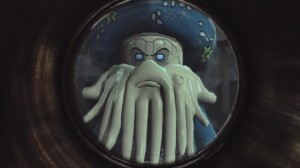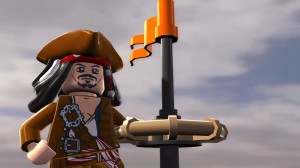LEGO Pirates of the Caribbean: The Video Game Review
by RadiumEyes, HSM guest contributor
When speaking of pirate movies today, the Pirates of the Caribbean franchise is a benchmark. Disney found a hit with the tale of Captain Jack Sparrow and his ragtag crew as they embark on various adventures and fight “exotic” villains in the process. Pirates of the Caribbean, however, shows to be a unique case in the genre – historically, pirate movies never made their money back, and most of them were pretty middling affairs that received poor critical attention. Even the Muppets couldn’t salvage success from its pirate outing, Muppet Treasure Island (another pirate picture helmed by Disney, along with Jim Henson Productions).
But Pirates became the exception, and Johnny Depp found new-found fame as Captain Jack Sparrow, a spry pirate who constantly outwits the British Empire. Eventually, games based on the franchise emerged, beginning with a 2003 PC and X-Box release – this game, an RPG, was originally intended to be a sequel to Bethesda’s Sea Dogs, and it remains more connected to that game than to the Pirates franchise. The LEGO company then joined in on the action with a May 2011 release which chronicles the four films so far released (a fifth film is confirmed) in classic LEGO form. Like the film-based LEGO games before it, LEGO Pirates of the Caribbean features a comedic version of the stories, with the cast replaced by LEGO men variants.
Based on a Ted Elliot script the original Pirates of the Caribbean film, Curse of the Black Pearl, established both Jack Sparrow and Barbossa as a classic protagonist-antagonist team. Several years and three additional films later, Pirates became a successful franchise, showing that pirates could be bankable at the box office. LEGO’s game based on the motion pictures combined them with one of the most popular toys to come out of the latter half of the twentieth century, and thus piracy in miniature became a reality.
Before going into the meat of this article, however, I would like to provide some history of the movie franchise.
Pirates of the Caribbean, as many of you already know, began not as a film, but as a theme park ride prominently featured in Disneyworld and Disneyland. The ride actually began life differently – Walt Disney envisioned a wax figure museum, illustrating the history of piracy in the Caribbean and along the U.S. Atlantic coast. However, this could not have exited at all – considering that Florida had been one of the various locales pirates actually visited in the early days of European exploration of the continent, it was originally thought to not be “exotic” enough for visitors to the park to fully enjoy. However, the project went through, and the wax figure museum was scrapped in favor of a dark ride – Walt Disney wanted more interaction with the pirate experience, and the ride allowed a better opportunity for that.
 As one might imagine, however, the ride doesn’t have a story – it provides riders a glimpse into an era where pirates dominated the area, and it was basically a dramatic interpretation of history. From a thrilling battle between a pirate ship and an English vessel, to the hectic life of a village occupied mainly by scurvy dogs, the ride showed visitors what life was like for pirates in a very Disney vein. And it includes the now-classic song, “A Pirate’s Life for Me,” which is always a joy to hear.
As one might imagine, however, the ride doesn’t have a story – it provides riders a glimpse into an era where pirates dominated the area, and it was basically a dramatic interpretation of history. From a thrilling battle between a pirate ship and an English vessel, to the hectic life of a village occupied mainly by scurvy dogs, the ride showed visitors what life was like for pirates in a very Disney vein. And it includes the now-classic song, “A Pirate’s Life for Me,” which is always a joy to hear.
Now, when time came for the film, Disney didn’t exactly have history on their side – as mentioned, pirate films fared poorly at the box office, and pitching a new one in the genre wasn’t exactly going to garner excitement. However, the film was green-lit, and it became a runaway success. The success of the franchise even permeated the ride on which it was based – modifications to the ride added characters from the films to it, so one can be sure of finally seeing Jack Sparrow, Barbossa and Davey Jones along the way when riding along in the boat.
This now leads to the LEGO game adaptation.
Traveller’s Tales developed it with Disney Interactive publishing; people may recognize Traveller’s Tales from earlier Disney games, such as Mickey Mania and games based upon Toy Story and A Bug’s Life. The company’s first releases were published through Psygnosis, but it later produced several games for other companies – the various LEGO games it made (from LEGO Star Wars to Legends of Chima) got published through such companies as Warner Brothers, Nintendo and (relevant to this article) Disney.
As one can gather from the above paragraph, this isn’t LEGO’s first foray into motion picture-based games – it tapped into that market earlier with game adaptations of Star Wars, Indiana Jones and the Harry Potter films. Unlike these earlier releases, however, LEGO Pirates is a stand-alone game without a sequel. This may very well change with the pending release of the series’ fifth film, but as it stands now, the game has all four movies included, each with five chapters to play through. This “hub system” allows players to access whichever film in the series they wish to, in whatever order, but they must complete the first chapter of Curse of the Black Pearl before the other films can be unlocked. Traveller’s Tales took this exact approach to the movie-license games they released prior to LEGO Pirates, so this isn’t new.
With all that said, how does the game fare?
LEGO Pirates has similar gameplay to earlier releases, but the game introduces a few unique elements to distinguish it from its predecessors. One of these is the forging ability – characters with a forging hammer can interact with glowing-red Lego devices to repair them. It’s a nice touch, as it shows how pirates aren’t always about swordfights and ship battles (and the occasional fight with a legendary creature). Aside from that, the game also has Blackbeard, who has an ability nobody else can use – interacting with black-and-red Lego constructions. Being Blackbeard, he’s a force to be reckoned with, and his appearance in On Stranger Tides cemented him as a crazy man who apparently has mystical powers.

Little touches like that make the game enjoyable in their own right, but what about the game as a whole?
Details don’t make the entire game, so one must take the whole product into account. Firstly, let’s look at the stuff that LEGO Pirates did well. Unlike LEGO Lord of the Rings (which got released after), LEGO Pirates uses a hub system for level access – Port Royal is the “main menu” here, where players can roam around and destroy/build/interact with various objects and characters at their leisure. Characters that must be purchased to unlock can be found here, walking about Port Royal; setting it up this way gives you the opportunity to choose which characters you wish to unlock first, instead of having to wait until the game unlocks them for you after fulfilling some challenge.
The Port Royal hub is divided into three sections – town, level access, and docks (the lattermost of which includes a tower and other assorted things). Thankfully, the hub is easy to navigate, and one does not have to go far to find anything. There’s plenty to do here, and there’s even a secret area available for players who manage to obtain all the gold bricks scattered throughout the game. I won’t spoil it for people, but it’s a fun surprise, one that will certainly endear to fans.
The main levels themselves are fairly expansive, with many secret areas that can only be accessed with specific characters. This definitely will help give the game some longevity, but I felt that these off-the-beaten-path areas add to the charm of the game. LEGO Pirates, like its forebears, revels in its comedic retelling of the films, and it adds numerous little jokes here and there to break up the tension. For example, the Singapore chapter of At World’s End includes a Punch and Judy-inspired puppet show that you can activate to distract British soldiers, allowing you to access a bridge the soldiers were blocking. In another level, this time in On Stranger Tides, Jack and Barbossa must get past guards, and they achieve this by preparing a turkey dinner that entices them, making them leave their posts and eat, giving you ample opportunity to leave without being detected.
As said, this game has some nice jokes, and this extends to the cut-scenes. Each level, when played in Story Mode, contains an opening and concluding cut-scene that gives context to the action, and they’re amusing as well. What makes them fascinating is that they’re done entirely without dialogue – the only verbal communication the characters engage in are nondescript utterances such as screams, laughter and grunts that indicate their general emotional state. It makes the scenes all the more ridiculous and fun to watch; spoken dialogue would have changed their impact, and I, for one, enjoy how the game pulled this off.
Each level has two modes – Story Mode and Free Play. Free Play cannot be accessed until a level’s Story Mode is completed, and it allows you to replay the level with whatever characters you’ve unlocked thus far. This means you can locate things that could only be discovered with certain characters; for example, there are shining metallic Lego pieces that can only be destroyed by explosives, and only a handful of characters have that available as an ability. The game gives you plenty of places to use various characters with special abilities, so having at least one character with a specific power in your party would be necessary for 100% completion.
Now for some of the drawbacks. The game’s cutscenes cannot be skipped at all, and some of them can drag on for a while. If you want to play the game over again, starting from the beginning, you’ll have to wait once more for the cutscenes to play again. It’s a little frustrating, not being allowed to skip, especially if you’ve already seen them and want to continue with the game. They may be funny, but having to see them every time you play Story Mode can dampen the humor. Having a skip function in place would help, then you don’t have to sit through several minutes of cutscene every time you start from scratch.
As far as glitches go, I can remember the case of character selection. LEGO Pirates offers you the chance to change to another character via a selection screen brought up via the triangle button; there are an incredible amount to choose from, and remembering which character takes up which slot can be a tad difficult. However, the oddest part is that when you make your choice, you can occasionally get an entirely different character, thus forcing you to return to the selection screen again to re-select the character you wanted. It’s a puzzling thing to see; trying to select Barbossa, for example, could inadvertently wind up giving you a mermaid. The game does allow you to change characters outside the selection screen – you tap the triangle button next to a character walking near you to switch – but that’s dependent on finding the character in the hub. For the selection menu, having a more stable means of ensuring you get the character you want would be most helpful.
Another issue, although not that major, is the fact that you can make the game practically impossible to lose if you obtain all the right Red Hat special powers. These range from stud multipliers to invincibility – the latter makes boss sequences anticlimactic, as you are no longer at risk of dying. The Star Wars games had that included, as well, and it effectively nullified the challenge. It does help in areas with many opponents, but overall it removes the risk.
Games feel more rewarding when you know you can lose; the LEGO games give you the chance to forego that entirely. Then again, LEGO games don’t exactly cater to the “hardcore gaming” demographic – they’re meant to be enjoyable romps through familiar and popular franchises. This I can forgive, as LEGO and Traveller’s Tales provide a nice comedic experience all around.
So, there’s the game.
Pirates, swordfights, ship battles, silly antics – everything you’d want in a LEGO game based on Disney’s Pirates of the Caribbean franchise. Even with the issues listed above, LEGO Pirates is an enjoyable outing for anyone. It’s a great release from Traveller’s Tales, and nothing will ever beat LEGO as a quintessential building toy. It’s not complicated, but it doesn’t have to be – LEGO games are fun, and reflect the joy many kids had when building their own LEGO worlds in real life.
If you haven’t played any of the LEGO film entries, this would be a great introduction. Some of the jokes and references would require knowledge of the films, but overall, you can follow the plot without needing to watch the series beforehand. As far as the films are concerned, I’d really recommend watching them to see the exact relationships and interactions between characters – knowing who knows whom certainly helps in figuring out what’s going on the film, and you can further understand the mythology of the franchise through that.
Share
| Tweet |






 Twitter
Twitter